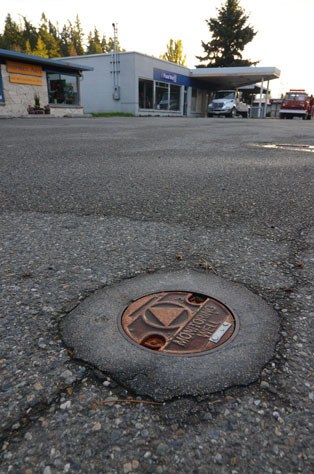The installation of four new monitoring wells that experts hope will reveal just how far an old fuel spill has spread through Freeland’s aquifer is still at least one month away, according to state officials.
Louise Bardy, supervisor of the state Department of Ecology’s voluntary clean-up program, said getting permission from neighboring property owners has taken longer than expected and that some issues still need hammering out. But, if all goes well, the work could be done as soon as next month, she said.
“Our best hope is that we’d have the wells in by November and (be) getting data shortly after that,” Bardy said.
In August, agency officials alerted Freeland Water and Sewer District officials that the area’s water supply was under threat from a 2005 fuel spill.
Up to 7,000 gallons of gasoline leaked from a holed underground tank at what was formerly Whidbey Marine and Auto Supply on Main Street. The former owner, Marty Winn, has been participating in the state’s voluntary clean-up program ever since, but the contaminants have reached Freeland’s sea-level aquifer — about 100 feet below the surface — according to data acquired from monitoring wells drilled around the old gas station.
Once alerted to the development, water district officials tested the district’s wells, which supply water to about 90 commercial businesses and nearly 400 residences, but no contamination was found.
At the water district’s monthly meeting in August, Ecology officials provided the commissioners with an update of the situation and expressed hopes of having additional wells in place by September.
They are expected to show just how far the plume has traveled underground, a framework for rate of travel, and whether immediate steps are necessary to protect the district’s wells, which are about 1,900 feet away.
But getting the new monitoring wells installed is taking longer than expected. Farallon Consulting, an Issaquah-based private consulting firm, is handling negotiations with private property owners on behalf of Winn, but progress has been slow.
Steve Myres, one of several property owners approached, said he has a host of concerns. Placement is one big worry, he said, because one of the two wells proposed for his property would be within 10 feet of his septic-system drainfield.
“It was nearly on top of it,” Myres said.
According to Bardy, responsibility for the bill to remove the wells once the monitoring ends is another big concern of property owners.
“That’s on the table still —who will pay for that,” Bardy said.
There has been some discussion about establishing an escrow account or fund, which would cover the expense, but nothing has been finalized yet, she said.
Andy Campbell, manager for the water district, said Farallon officials are providing district leaders with weekly progress updates but, as of Thursday, there is no firm timeline for when well work will begin.
There are complicated and difficult obstacles that need to be overcome but district officials are eager for news about the plumes progress, he said.
“We consider this a serious issue as it relates to water quality and we’re anxiously awaiting more information,” Campbell said.



